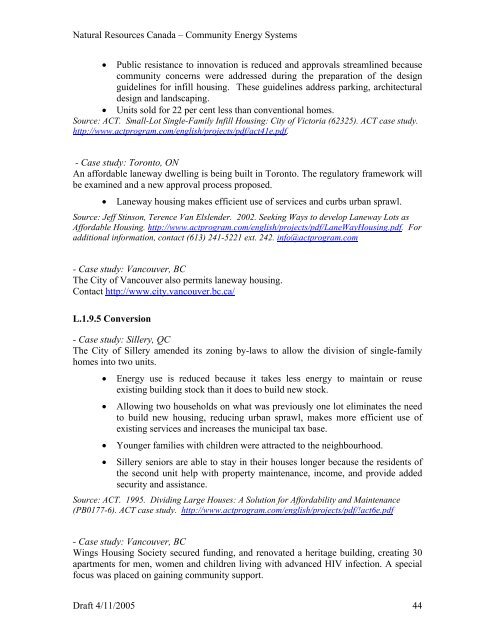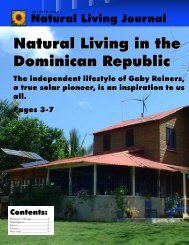Volume 3 - Program & Project Ideas (PDF - 4.5 - Natural Life Network
Volume 3 - Program & Project Ideas (PDF - 4.5 - Natural Life Network
Volume 3 - Program & Project Ideas (PDF - 4.5 - Natural Life Network
Create successful ePaper yourself
Turn your PDF publications into a flip-book with our unique Google optimized e-Paper software.
<strong>Natural</strong> Resources Canada – Community Energy Systems<br />
• Public resistance to innovation is reduced and approvals streamlined because<br />
community concerns were addressed during the preparation of the design<br />
guidelines for infill housing. These guidelines address parking, architectural<br />
design and landscaping.<br />
• Units sold for 22 per cent less than conventional homes.<br />
Source: ACT. Small-Lot Single-Family Infill Housing: City of Victoria (62325). ACT case study.<br />
http://www.actprogram.com/english/projects/pdf/act41e.pdf.<br />
- Case study: Toronto, ON<br />
An affordable laneway dwelling is being built in Toronto. The regulatory framework will<br />
be examined and a new approval process proposed.<br />
• Laneway housing makes efficient use of services and curbs urban sprawl.<br />
Source: Jeff Stinson, Terence Van Elslender. 2002. Seeking Ways to develop Laneway Lots as<br />
Affordable Housing. http://www.actprogram.com/english/projects/pdf/LaneWayHousing.pdf. For<br />
additional information, contact (613) 241-5221 ext. 242. info@actprogram.com<br />
- Case study: Vancouver, BC<br />
The City of Vancouver also permits laneway housing.<br />
Contact http://www.city.vancouver.bc.ca/<br />
L.1.9.5 Conversion<br />
- Case study: Sillery, QC<br />
The City of Sillery amended its zoning by-laws to allow the division of single-family<br />
homes into two units.<br />
• Energy use is reduced because it takes less energy to maintain or reuse<br />
existing building stock than it does to build new stock.<br />
• Allowing two households on what was previously one lot eliminates the need<br />
to build new housing, reducing urban sprawl, makes more efficient use of<br />
existing services and increases the municipal tax base.<br />
• Younger families with children were attracted to the neighbourhood.<br />
• Sillery seniors are able to stay in their houses longer because the residents of<br />
the second unit help with property maintenance, income, and provide added<br />
security and assistance.<br />
Source: ACT. 1995. Dividing Large Houses: A Solution for Affordability and Maintenance<br />
(PB0177-6). ACT case study. http://www.actprogram.com/english/projects/pdf/!act6e.pdf<br />
- Case study: Vancouver, BC<br />
Wings Housing Society secured funding, and renovated a heritage building, creating 30<br />
apartments for men, women and children living with advanced HIV infection. A special<br />
focus was placed on gaining community support.<br />
Draft 4/11/2005 44






